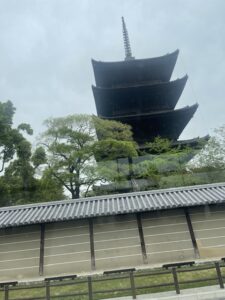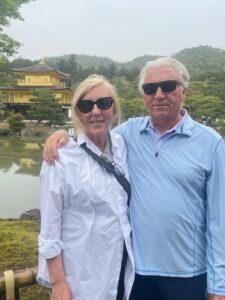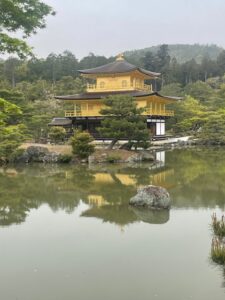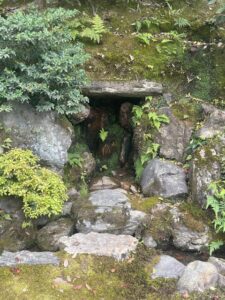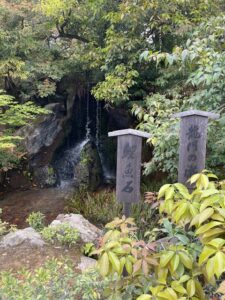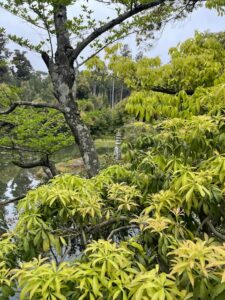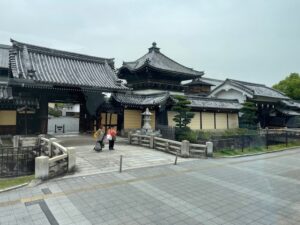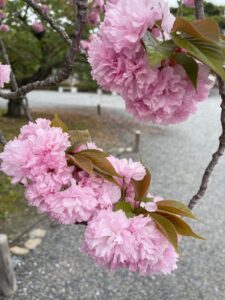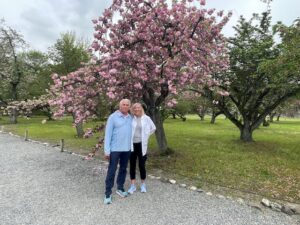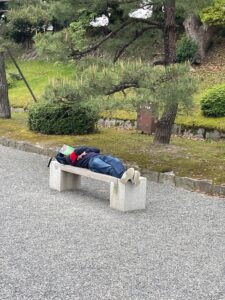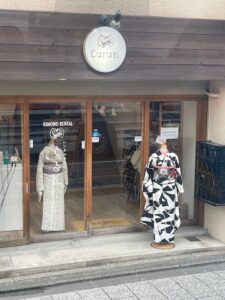
Kobe is located along the tranquil shores of the Seto Inland Sea. Its 1.5 million residents have a resilient spirit that has overcome the devastation of the Great Hanshin Earthquake in 1995. Over 4500 people lost their lives in this tragedy. Kobe is a very active trade port and is famous for its Kobe beef. Kobe beef cows are massaged, fed beer and listen to classical music prior to their demise. Our guide said they that are, “so happy then so delicious.” Our guide today was an absolute delight, Soda was 79 years old and had been very educated over the course of her years. She spoke the Kings English and her enunciation was perfect and she could also do an English accent, a Scottish accent and an Australian accent. She was very knowledgeable and entertained us all day with her stories.
We spent very little of our time in Kobe. Our excursion today was to Kyoto. We drove through Osaka on our way out of the city. I spent time in Osaka years ago when I was a flight attendant and it had, of course, changed a great deal during the time that has passed. We traveled about an hour and a half before arriving in Kyoto. Originally the seat of Japan’s imperial court from 794 to 1868, Kyoto today remains the cultural capital of Japan. As we made our way through the countryside, we passed the Toji Temple, which at 180 feet, is the tallest pagoda in Japan: and the Kyoto Tower, Kyoto’s tallest modern structure.
Our first stop was at the UNESCO World Heritage Site Kinkakuji, covered with gold leaf. It is also known as the Golden Pavilion, one of the most popular attractions in Japan. Built in 1397 as a shogun’s retirement villa and converted to a Zen temple upon his death, it sits in the center of a magnificent garden with a wooden pavilion that extends over a reflecting pond. But the most notable feature is its glimmering exterior – gold leaf gilds the upper two stories.
Our next stop was what Joe has started calling our “bus lunch”, enjoyed at a local hotel. Today we were served a western lunch of salad, meat and potatoes. It was lovely but I might prefer the cuisine of the local area. I’ve enjoyed tasting each meal we have be served. Even if you don’t like it, it is a snapshot of what the locals typically eat. And, I might add, we are never short of food on this cruise so if you leave hungry you’ll soon have plenty to eat. We’ve giggled with friends about how the laundry might be shrinking our clothes. I know that most of us have gained at least a few pounds, if not from eating then from the constant availability of liquor.
After lunch our next stop was the Nijo Castle which was completed in 1626 as the Kyoto residence of Tokugawa Ieyasu, the founder and first Shogun of the Tokugawa Shogunate (1603-1867). The castle was built for his residence and not as a fortress. The Donjon of the Castle was destroyed by fire. But the Ninomaru (Second inner Palace) remains. The Ninomaru Palace was built to impress visitors with the shogun’s power and wealth. Built almost entirely out of cypress, the extravagant interiors are lavished with gold leaf and elaborate wood-carvings. For the shogun’s protection, the builders constructed what’s known as “nightingale” floors; if an intruder entered the corridors, the floors would squeak like birds. Some of the rooms in the castle also feature special doors and secret rooms where bodyguards would hide. The gorgeous carvings and screen paintings are most elaborate. Photography was not allowed so I’m unable to share any of the beauty we saw here.
